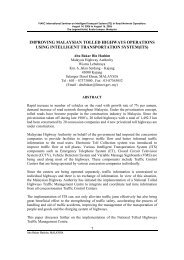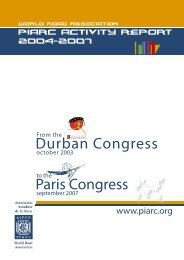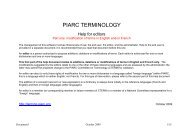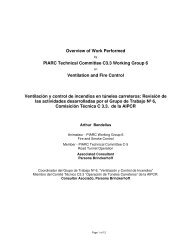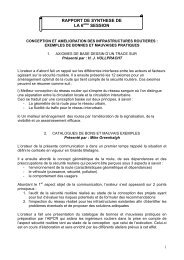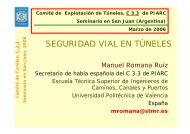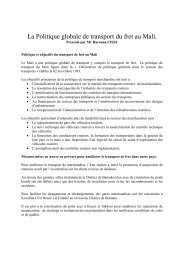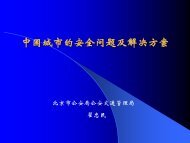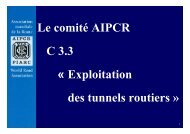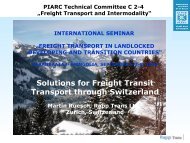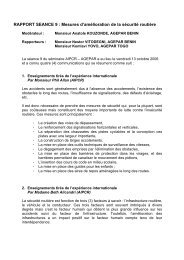General proceedings - Association mondiale de la Route
General proceedings - Association mondiale de la Route
General proceedings - Association mondiale de la Route
You also want an ePaper? Increase the reach of your titles
YUMPU automatically turns print PDFs into web optimized ePapers that Google loves.
Highlights of the presentation:<br />
• A dol<strong>la</strong>r saved on maintenance increases vehicle-operating costs by up to US $ 10 over<br />
the life of the road.<br />
• The cost of rehabilitation/ reconstruction can be up to 20 times more expensive than the<br />
cost of sustained maintenance over the life of the road.<br />
• Fuel levy at US 10 cents per litre is consi<strong>de</strong>red optimal level. Increasing it further affects<br />
inf<strong>la</strong>tion and retards economic growth.<br />
• It is advised not to use Overloading fees/fines for p<strong>la</strong>nning purposes.<br />
• Tanzania wants to introduce an Annual Access Fee to be charged to all vehicles using the<br />
roads. The fee is to be structured to reflect the re<strong>la</strong>tive damage done by a vehicle.<br />
• An infrastructure levy of 1% of CIF on all imports is proposed.<br />
Title: Road Asset Valuation & Management - Case Study Fin<strong>la</strong>nd<br />
Author & Presenter: Jani Saarinen (pictured), Executive Director, Rakli- The Finnish<br />
<strong>Association</strong> of Building Owners and Construction Clients, Fin<strong>la</strong>nd<br />
The presentation was based on Road Asset<br />
Management, which the presenter stated, was about<br />
managing roads like a business. The term ‘asset<br />
management’ is increasingly being used to<br />
characterise a ‘business-like approach’ to road<br />
network management at a time where Road<br />
administrations are moving from purely governmentcontrolled<br />
organisations with their own executive<br />
<strong>de</strong>partments to agency status. Mr. Jani Saarinen<br />
exp<strong>la</strong>ined that each road asset has both an economic, and a capital value, calcu<strong>la</strong>ted from<br />
either the cost of repairing the asset to its as built condition or the cost of rep<strong>la</strong>cing the asset.<br />
Valuation of the road asset, based on good engineering, technical tools, and mo<strong>de</strong>rn<br />
accounting, has ma<strong>de</strong> road management more efficient and transparent. Asset value is a<br />
significant factor in <strong>de</strong>termining priorities for the future investment The presenter provi<strong>de</strong>d<br />
an example of how Road Asset Management was implemented in Fin<strong>la</strong>nd.<br />
Highlights of the presentation:<br />
• The key difference between traditional management systems and asset management<br />
system is that the <strong>la</strong>tter requires implementing of an accounting and valuation of assets in<br />
monetary terms.<br />
• Asset management inclu<strong>de</strong>s the following elements: Inventory of assets; Road<br />
management systems; Valuation of the assets; Accounting; and Information.<br />
• Valuation of assets is done to enable reporting in monetary terms to reflect the physical<br />
conditions of the road network, and to assist asset managers inform asset owners of the<br />
effects of financing strategies.<br />
• The <strong>de</strong>preciation to be written off yearly should be p<strong>la</strong>nned beforehand and confirmed<br />
according to local accounting standards and requirements. I<strong>de</strong>ally, the amount of<br />
<strong>de</strong>preciation should correspond with the actual wearing and consumption of an asset.<br />
31



